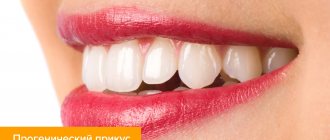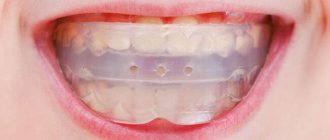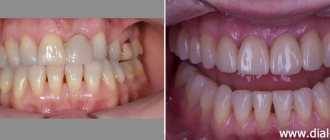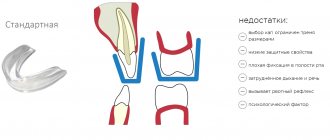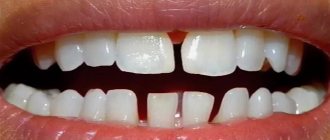Many conscripts whose father, uncles, cousins or brother served in the army have a normal attitude towards the responsibility of learning to defend themselves, loved ones and their homeland. And those whose father studied with him and had a military service, friends talk about the army as something terrible, they themselves are afraid, they don’t want to go there. Such guys, when they are practically healthy, place their last hope on a slight deviation in health and ask the orthodontist: “Are they recruited into the army with an incorrect bite?”
How to determine the degree of malocclusion
This term refers to the incorrect arrangement of teeth in a closed state. The defect, in most cases acquired, often develops in the first year of the baby's life. As you get older, the situation gets worse.
The main causes of malocclusion include:
- Artificial feeding using a pacifier, sucking a pacifier.
- Incorrect head position during feeding and sleeping.
- A bad habit is thumb sucking.
- Frequent diseases of the nose - sinusitis, congestion. The child breathes through the mouth, an incorrect taste is formed, and an “adenoid” type of face develops.
- Genetic data - heredity.
In addition, one of the main reasons for the formation of malocclusion is abnormal tooth growth. If you do not respond to the problem in a timely manner, the jaw and face as a whole become distorted. In this case, braces are used to correct the bite.
Types and classification of abnormal bite:
- Mesial, medial . It can be true or false. It is determined by the advancement of the lower jaw relative to the upper. One of the most difficult anomalies, practically impossible to treat.
- Distal, prognathic . Protrusion of the upper jaw forward or a severely underdeveloped lower jaw that does not reach the upper teeth.
- Deep . A common anomaly, as a result of which there is a strong overhang of the upper jaw over the lower jaw - by 1/3 of the crown of the incisors.
- Open , disocclusion . Rarely seen. There is a noticeable gap between the teeth when the jaws close. This phenomenon causes difficulty chewing food and incorrect pronunciation of certain sounds and words. There are anterior, posterior, lateral, false, true, unilateral, bilateral, gnathic, dentoalveolar. Difficult to treat.
- Cross, scissor . It represents the intersection of the dentition in the horizontal plane. An incorrect smile and pronunciation of words are formed. There are buccal and lingual types.
The Agapov classification helps to assess the severity of the anomaly. If the closure separation is observed to be 5-9 mm, they speak of malocclusion of the 2nd degree, less than 5 mm - 1st degree, more than 9 mm - 3rd degree. The quality of chewing food is also assessed. The substrate is examined under a microscope, the percentage of grinding is calculated, and compared with normal values.
An abnormal bite can be determined visually, but a specialist must make a diagnosis and record it in the outpatient chart. In most cases, with a timely response from parents to the problem, the situation is resolved for the child. It is more difficult for an adult to correct a defect.
Reasons for the incompatibility of abnormal bite and military service
The army requires conscripts to speak clearly, and one of the consequences of an abnormal bite is impaired diction.
This is not the only problem that occurs in people with pathological closure of the dentition. Other complications include:
- Facial deformation.
- Gum diseases.
- Difficulty digesting and assimilating food.
- Disturbances in the functioning of the respiratory system.
- ENT diseases.
- Damage and premature wear of tooth enamel, etc.
Some forms of deformation are incompatible with the conditions of military service. Complex bites include deep bites when the upper teeth overlap the lower teeth by more than half their length. A severely protruded upper jaw is considered a serious deviation. This sign characterizes the distal bite.
If there is a lack of contact between the lateral and anterior teeth during closure, the anomaly is designated as an open bite.
According to orthodontic indications, all forms of severe tooth displacement that disrupt digestion and affect the functioning of other systems and organs are grounds for dismissal from service or granting a deferment. This is due to the fact that the army does not have the ability to provide military personnel with the necessary medical care and services.
With minor deviations in the structure of the dental system, there are no obstacles to military service, but there are restrictions. For example, those liable for military service are not allowed to join the flying troops.
Serving in the Air Force involves frequent use of breathing apparatus with mouthpieces. The recruit will not be drafted into the elite troops (Navy, Airborne Forces, Ministry of Emergency Situations, etc.), since among the requirements for conscripts is the presence of category “A” for health reasons.
Do they take into the army with a deep bite?
According to Article 56 of the Schedule of Diseases, a conscript has the right to be exempt from military duty in two cases:
- anomaly of 2 degrees with separation of 5-10 mm, with chewing activity less than 60%.
- anomaly of 2, 3 degrees with separation of more than 10 mm.
All other forms are conscription. The defect in grades 2 and 3 of malocclusion is visible to the naked eye. The conscript is sent for additional examination to determine the degree of chewing of food. If the anomaly can be eliminated, the young man is offered surgery. If the procedure is successfully completed, the summons will be served after 6 months. If it is impossible to eliminate the defect or the conscript refuses the operation, he is assigned fitness category “B” and released from service.
How the face changes due to impaired jaw closure
Malocclusions carry a pronounced cosmetic defect
. This is an unattractive smile, changes in facial proportions, for example, a too protruding lower jaw, a constantly slightly open mouth. A massive, heavy chin also does not add attractiveness to the face, because it makes the jaw look much larger.
Photo 3. A woman’s face in profile with a malocclusion (left) and after correction of the pathology (right).
The appearance of gaps between the lateral dental sections causes facial asymmetry and the effect of “sunken cheeks”
as if the lateral teeth were completely absent. To all this you can add a somewhat confused and surprised-stupid expression on the face, which does not suit the person at all.
Of course, an incorrect bite changes the face and asymmetry appears. This happens because the teeth on one side wear away faster. With age, this problem only increases.
Anomaly of 2 degrees with separation of 5-10 mm
According to Art. 56 Schedules of diseases, item “b”, fitness category “B” is assigned for defects of the lower jaw, the presence of transplants after surgery. Pre-conscription conscripts upon initial registration with the military registration and enlistment office are considered to be of limited fitness - category "G" if less than 6 months have passed since the operation.
In case of malocclusion of the II degree with a separation from 5 to 10 mm with a chewing efficiency of less than 60%, in case of an malocclusion of the II, III degree with a separation of the bite of more than 10 mm (without taking into account the chewing efficiency), suitability category “B” is assigned. In case of malocclusion of the II degree with separation from 5 to 10 mm with a chewing efficiency of 60% or more percent - “B”.
For those examined with non-removed metal structures after osteosynthesis of fractures of the maxillary bone and (or) mandible with minor or no impairment of respiratory, olfactory, chewing, swallowing and speech functions, paragraph “B” applies.
If there is a malocclusion of the first degree, a displacement of the dentition by less than 5 mm, the conscript is drafted into the army.
Diagnostic techniques
To know how to effectively correct malocclusion, you need to make an accurate diagnosis. To determine the manifestations of pathology, additional measures are taken:
- X-ray pictures. West Dental has the Pax-i3D CBCT, which can perform OPTG, CT, and TRG. The ratio of the sizes of the jaws, teeth and bone volume, and the condition of the TMJ are determined.
- 3D scanner. The patient is shown a picture of changes in facial and dental signs of occlusion before and after orthodontic intervention.
- Photo protocol. A collection of photographs of the jaw relationship before, during and after treatment or jaw surgery allows you to trust the doctor. The results are visible at all visits.
How does a military commission make a decision?
If there is an abnormal arrangement of teeth, you should seek help from a dentist. The diagnosis, the degree of chewing dysfunction, and the severity of the disease are determined by a specialist. The information is recorded in the outpatient card. You must take a photocopy of the statements with you to the commission at the military registration and enlistment office.
The commissariat examines the conscript, studies the preliminary notes of doctors, and sends him for additional examination. After re-confirmation, a fitness category is assigned. If the defect can be corrected with treatment, a deferment is given for 6-12 months, after which the conscript’s case is reconsidered.
Prevention
Adults need to regularly take their child to a consultation appointment with a pediatric dentist and orthodontist once every six months. Treatment of pathological foci in mammary units should be carried out in a timely manner. For harmonious sleep, you need to buy your child a suitable pillow.
After 3 years, you need to monitor the grinding of your child’s teeth, which is a natural process. If this does not happen, then grinding is necessary, otherwise the NP will not take its natural anatomical position. Also, in this age interval, interdental spaces appear, which is normal. Jaws grow, and emerging molars need a lot of space. If there are no gaps, then a malocclusion may occur, so you need to contact a specialist to monitor the situation.
Doctors at the branches of family dentistry West Dental in Yanino-1 and Vsevolozhsk offer effective correction of bite pathology using modern treatment techniques, at a reasonable price. An understanding of the prevention and treatment of dental pathology is formed. To make an appointment with our specialists, you can fill out the online form on the website or by calling the administrators.
Will they be accepted into the army with braces in 2022?
Professional installation of braces is an expensive procedure that requires constant supervision by specialists and special dental care. Special food is provided. In the army, all these conditions cannot be met. However, according to the Schedule of Diseases, exemption from the army with fitness category “B” is not allowed. The exception is surgery to correct a grade 2 malocclusion with a separation of more than 5 mm.
In some cases, the military commissariat meets the conscript halfway, gives him time to complete his treatment, assigns category “G”, after which a re-examination is scheduled. If a young man has braces, he should consider removing them before going into the army, since it will not be possible to provide full care for the oral jaw.
Treatment methods
Treatment of occlusion is divided into an active period and a period of retention (consolidation of the result).
Depending on the patient’s situation, at the active stage the doctor can offer him several correction options:
- aligners (aligners),
- trainers,
- records;
- orthodontic devices;
- braces,
- surgical intervention.
Mouth guards
They are transparent soft plates made of silicone, polyurethane and other material, made for a specific person. They are worn for at least 22 hours, removed for eating and brushing teeth. They are practically invisible in the mouth, wear comfortably and do not cause harm to the oral cavity. Every 3 weeks they change to harder ones.
In case of serious pathology, mouthguards are ineffective. They show good results only in cases of crowded teeth, narrow or wide arches, and recurrent displacement. Combined with their high cost, aligners are rarely prescribed or as a preventive measure.
Trainers
The silicone device is similar to a mouthguard, but much more massive. Trainers are intended to be worn at night; during the day they should be used for no more than 4 hours. They cope, again, only with minor bite defects.
The listed systems are best suited for patients under 12 years of age. At an older age, they are prescribed to consolidate the result of correction or prevention.
Braces
Braces are prescribed to adolescents or adult patients for almost any malocclusion pathology. In children, the jaw is actively growing, so they are prescribed to wear removable plates.
Externally, braces are plates connected by an arc. They are attached to the tooth(s) using medical adhesive.
The whole secret of alignment is in the arc. Possessing shape memory, it tries to return to its original state, being deformed when installed on a problematic tooth or teeth.
Important! At the very beginning of treatment, the system is elastic. Over time, it is replaced with a tougher one.
Braces are classified as follows:
- Depending on the place of attachment - vestibular and lingual. The first are installed on the outside of the teeth, the second - on the inside. The latter are invisible, but can cause discomfort to the patient, since the tongue is constantly in contact with them. Because of this, diction may be temporarily impaired. In addition, they are more expensive to maintain than vestibular ones.
- According to the method of attaching braces to the power arch - ligature, non-ligature, self-adjusting. The first ones are considered classics. Fastening is provided by ligatures (metal wire) or elastic rings. At a fairly low cost, they show good results. However, ligature braces require frequent visits to the orthodontist and thorough cleaning to avoid discoloration. In addition, correction with their help is quite unpleasant. In non-ligature models, the arc is secured using special movable clamps (latches, latches, etc.). It is not so hard, which reduces discomfort. And the braces themselves do not take up much space on the teeth. It is much easier to care for and adjust them in the dentist’s office. It is not surprising that they are more expensive than ligature ones. But the most expensive models are self-regulating. They are made individually, taking into account what the teeth should look like after treatment. During wear, frequent visits to the orthodontist are not required. In addition, there is no danger of injury to the mucous membranes.
- Depending on the material : plastic, metal, ceramic, titanium, sapphire, silicone. The first ones are the most accessible and inconspicuous, but they can change color and are fragile. Metal ones are also available, and are much stronger, but are visible on the teeth. Braces made of polycrystalline ceramics are matched to the natural color of the enamel, are invisible and wear well, but can change color under the influence of food and drinks. Silicone ones are much softer, but are rarely used. The most expensive product is made from artificial sapphires. At the same time, they require careful hygiene and careful use. Titanium braces are hypoallergenic, lightweight and secure, but again, noticeable.
The price of a bracket system depends on its type and the material used.
Any of the above requires careful care. They should be cleaned with special brushes for 7-10 minutes in the morning, evening, and after each meal.
Important! With age, contraindications to the use of certain systems arise. In addition, the older the patient, the more difficult it is to change the position of the teeth and affect the bone tissue. Therefore, it is necessary to correct the bite, even with the help of braces, as early as possible.
During the period of retention (consolidation of the result), the patient is prescribed to wear mouth guards or trainers. This period lasts approximately as long as the braces were worn.
Surgical intervention
A radical method is resorted to if the bite is severely deformed and all the above methods of correction will not give results.
The intervention is accompanied by an incision in the gums and bone tissue in order to close the jaws and return the correct position of the teeth.
Malocclusion is a serious problem that can best be corrected in childhood. For this, various devices can be used (from mouth guards and plates to braces). The process will take a year or two, but will correct the bite and prevent complications in the future.
The older a person is, the more contraindications he has for certain corrective interventions. In addition, correction requires more time and effort for both the patient and the orthodontist.
Reviews
Dear readers, you can leave your feedback on whether people with an incorrect bite are accepted into the army in the comments, your opinion will be useful to other users of the site!
Andrey
“Theoretically, we can do everything, practically nothing. You still need to be able to prove an incorrect bite. They are sent to the army with major defects.”
Oleg
“I got braces shortly before the commission at the military registration and enlistment office, I thought it would help me get a deferment. No, they said, take it off and go ahead and serve.”
Who is considered fit for service?
According to the degree of health suitability for military service, there are categories:
- "A".
- "B".
- "IN".
- "G".
- "D".
What category you have will be determined by the military medical commission when you undergo a medical examination. Group “B” is called up, but group “C” is not. Some fairly healthy young people want to break the law and want to be assigned category “B” and released from service.
Before passing a special medical examination, it is best for you to visit doctors and ask how healthy you are, are you subject to compulsory conscription or not? All categories except the last “D” are subject to change.
For example, at the time of conscription your arm was broken and you received category “G”. After 2 months the bones will heal during a second medical examination after 6 months. and moreover, you feel great. You may be given category “A” or “B” and taken to serve in the army.
Categories
Let's take a closer look at the categories:
- "A" is good health. Fit for military service.
- “B” health is normal, but there are some limitations. Detected deficiencies do not prevent you from serving. For example, myopia is slight.
If you have category “B”, then it is customary to specify: “B-1” or “B-2”, which means “B-3”, etc. 1, the most that the restrictions are less than with 3. Conscript with “B” will not be hired to serve in the navy or as a paratrooper. They recruit strong young men there.
- Your “B” is fit for service, but with restrictions. In fact, experts believe that he is not fit to have serious health problems. You will not be drafted, but will be enlisted honorably in the reserve.
- “G”, it is believed that the young man is currently (temporarily) serious about serving, and later, when he recovers, for example, from an injury of varying severity, the military registration and enlistment office will send him a summons. There will be a chance in 6 months. or 1 year to enter the service.
- “D” Thus, he is definitely unfit to serve. There will be no re-examination.
Next Conscription into the armyDo people with kyphosis join the army?
Types of bracket systems
The existence of a wide variety of brace systems is explained by the fact that for many people wearing them has become not only of a health-improving nature. If a person wears braces for a long time and wants to look decent at the same time, then he may have a desire to purchase visually more beautiful models:
- Plastic ones are affordable for most patients, but the low cost comes at the cost of fragility. Best suited for treating mild bite problems for a short period of time.
- Metal braces are one of the most common correction methods due to their low cost and effectiveness. The metal is durable and easy to clean.
- Ceramic braces are gaining popularity due to the fact that plates of the right color can be almost invisible to the eye. “Ceramics” does not change color over time, practically does not cause allergies, and in terms of strength it is slightly less than metal.
- Sapphire braces are based on single crystals of an artificial mineral. They have a transparent appearance, are practically invisible to others, and require careful handling since they are more fragile, unlike their metal and ceramic counterparts.
- Lingual braces - the high price is compensated by their complete invisibility to others. They are placed on the inside of the teeth so as not to show signs of treatment of the jaw apparatus. These braces are made of gold and metal, which also justifies the cost.
Number of teeth
You need to remember whether your permanent teeth were removed and whether your wisdom teeth (eights) erupted.
- The normal number of teeth in a person is from 28 to 32.
- 28 – if not a single eight has erupted and other permanent teeth have not been removed.
- 32 – if all wisdom teeth have erupted and all teeth are preserved.
What if you have fewer than 28 teeth but have never had your permanent teeth removed? This means that either some teeth are impacted (they did not erupt and remained in the jaw in their infancy), or they do not exist at all. This condition is called partial edentia. You can find out where the missing teeth are by getting a diagnosis from an orthodontist. But most likely, if there are problems with teething, then the bite is also disturbed.
Impacted teeth in the picture
Position of individual teeth
What is most striking is the uneven position of individual teeth. They can be tilted, rotated, pushed forward or pushed back relative to others.
Crowding of the upper teeth
Protrusion of teeth (excessive tilting)
Rotation of teeth (they are rotated along their axis)
If the position of the teeth is disturbed, the bite as a whole may be correct, but this is rare. Since all teeth strive to form contact, if some are deviated, others will deviate as well. Therefore, treatment is almost always required not only to straighten teeth, but also to correct the bite.
